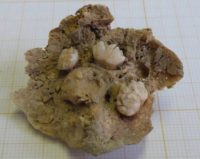I can’t believe it’s been almost four years since my last ovarian teratoma story. Just goes to show how rarely they survive in an archaeological context. Well, if there’s a better way to usher in a new year than with a centuries-old calcified mass of tissue and teeth, I don’t know of it.
 Today’s teratoma was discovered in the cemetery of the Church and Convent of Carmo in Lisbon, Portugal, a private burial ground for the religious of the order and its (largely middle class) patrons. It was in use from the 15th century until the 1755 Lisbon earthquake shut it down for good. The cemetery was only recently excavated by Lisbon Archaeological Centre archaeologists in advance of an urban renewal project. During its second dig season in March of 2011, the LAC team encountered skeletal remains with a large calcified mass in the pelvic area. Only the lower half of the body could be recovered at that time. The rest was unearthed in February of 2014, making it possible for all the remains of the individual to be studied.
Today’s teratoma was discovered in the cemetery of the Church and Convent of Carmo in Lisbon, Portugal, a private burial ground for the religious of the order and its (largely middle class) patrons. It was in use from the 15th century until the 1755 Lisbon earthquake shut it down for good. The cemetery was only recently excavated by Lisbon Archaeological Centre archaeologists in advance of an urban renewal project. During its second dig season in March of 2011, the LAC team encountered skeletal remains with a large calcified mass in the pelvic area. Only the lower half of the body could be recovered at that time. The rest was unearthed in February of 2014, making it possible for all the remains of the individual to be studied.
Osteological examination confirmed the individual was a woman between 5″1 and 5″3′ in height who was more than 45 years old when she died. In her pelvic girdle was a calcified mass that was the same color and texture of her bones. It is small, 1.5″ in length and only a sliver more than that in diameter. Teeth were visible embedded in the inner surface of the base. Researchers cleaned the mass thoroughly and were able to observe irregular, erratic bone formation on the outer and inner surfaces and five malformed quasi-teeth. Four are molar-like, one canine-like. One of the molariform teeth is more malformed than the others, missing any semblance of a root. An X-ray of the teratoma found no further bone structures in the mass.
 There’s no way of knowing with certainty whether the mass had an impact on her health or her cause of death. Teratomas are almost always benign and can easily go undiagnosed because they’re not really bothering anyone. Occasionally their shape, size and location can result in organ shifts, infections, anemia, but there is no evidence at all on the bones — no lesions or deformations.
There’s no way of knowing with certainty whether the mass had an impact on her health or her cause of death. Teratomas are almost always benign and can easily go undiagnosed because they’re not really bothering anyone. Occasionally their shape, size and location can result in organ shifts, infections, anemia, but there is no evidence at all on the bones — no lesions or deformations.
While there is no osteological evidence of what did claim her life, she was buried under a thick layer of lime, unusual in that context. If the people who put her in the grave covered her with lime, it’s likely they thought she had died of an infectious disease.
Your first paragraph had me laughing out loud. Thank you!
Fetus in fetu and fetiform teratoma 😮
i remember reading somewhere that these things (teratomas and other funny looking tumors) are the basis of many legends about women having ungodly sex with the devil, and these are the proofs (for being a witch, since they supposedly have sex with the devil).
as a pathologist who gets these routinely, i find them are rather interesting to look at, even after many years. the hair always get me. 99% of the time they have hair. you don’t see hair in these old 500 y.o. specimens b/c the only thing left is the rock hard components like bone and teeth. but they have brain, skin, hair, and even muscle and fat. it’s like the buffet. got everything.
these teratomas tend to be discovered unintentionally, and they don’t grow too big most of the time. there are rare instances that malignancy can arise of the benign parts, and you can get weird endocrine problems from having thyroid tissues from these. what make me fascinated is that they likely contain stem cells for being very primitive tumors, and maybe one day they can be harnessed for cancer fighting capabilities.
forgot to mention one more thing: the hair is just like the one on your head. if a blonde, blonde teratoma hair, etc. you can tell the race of the teratoma by looking at the hair. lol.
Teratomas are relatively common tumors thanks to their detection by CT scan or ultrasound. Anytime a woman has pelvic/abdominal pain that is unexplained (at least in the USA), they are scanned and if a mass is seen, surgery inevitably results (whether or not the mass had anything to do with the pain). The most common form is a “dermoid cyst” which is composed primarily of sebaceous glands and hair follicles which results in the formation of a mass that includes a greasy ball with associated hair. People seeing this for the first time are inevitably disgusted. By definition, teratomas are benign but can rarely turn malignant (e.g. teratocarcinoma). The likelihood that this woman’s mass had anything to do with her death is extremely unlikely.